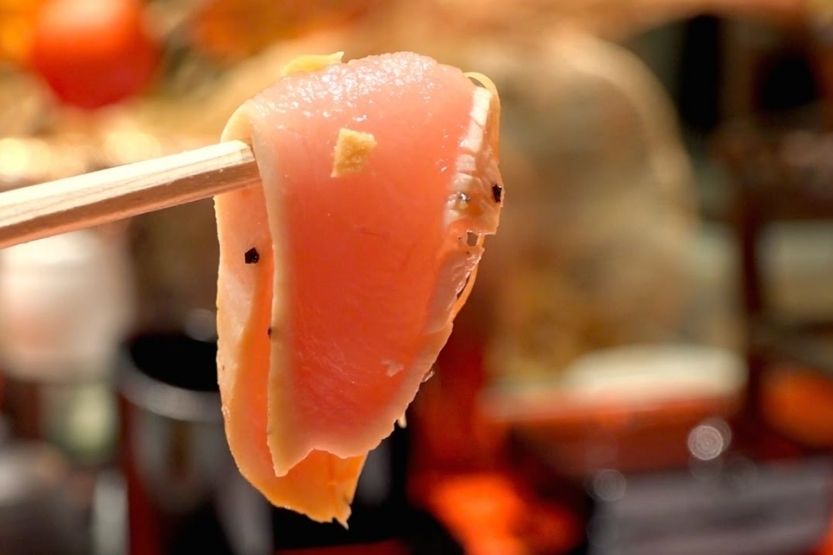You have always heard that you need to be careful when handling raw chicken. This is even more so to avoid eating raw chicken. So, what’s the deal with chicken tartare? Is it real, and is it safe to eat?
Several restaurants in the US are reportedly serving raw chicken dishes, referring to them as either chicken sashimi or tartare. In Japan, chicken sashimi is easier to find. However, just because restaurants serve them does not necessarily mean they are safe to eat.
Read on to learn more about chicken tartare and if it is safe for you to eat it.
What Is Chicken Tartare?

Sliced Uncooked Chicken with Herbs
If you go just by the name, chicken tartare refers to uncooked chicken, sliced and served with herbs and spices. Technically, it is sashimi, but it uses chicken instead of fish.
Is Chicken Tartare Safe to Eat?
You can find chicken tartare served in only a handful of restaurants in the US. Most of them are Japanese-themed. Even if you are an adventurous eater, it is still not wise to try eating chicken tartare.
Why Is Chicken Tartare Not Mainstream?
Raw chicken meat is a hotbed for many deadly bacteria, not the least of which is salmonella. Even mishandling raw chicken meat can lead to food poisoning.
This is the biggest reason you can’t see chicken tartare served in many restaurants in the US. It is easier to find this dish in Japan but not by much.
Chicken tartare, torisashi, or chicken sashimi has gotten quite rare in Japan. Since the Japanese Health Ministry instructed that you must cook all chicken dishes to a proper temperature.
This was in 2016 when over 800 people got food poisoning due to eating torisashi
In most cases, you will need a special license to serve chicken tartare in your restaurant. You also need to undergo intense food preparation training. Even if you find a high-end restaurant serving chicken tartare, you still take a huge risk eating it.
Can You Make Chicken Tartare at Home?
Technically, there are lots of recipes for chicken tartare online. However, this is a textbook example of “just because you can, does not mean you should.” There is a reason why there are not many restaurants in the US that serve chicken tartare. You have to do it in a spotless working area.
Chicken tartare is not something an amateur home cook should attempt. Many have tried and ended up in the emergency room.
You may be lucky enough if you get mild food poisoning. Still, three to four days of nausea and diarrhea will not be pleasant. If you want to try chicken tartare, at least get it from a reputable restaurant.
How to Deep Fry Frozen Chicken Wings
What Bacteria Does Raw Chicken Have?

You can get foodborne food poisoning from eating and even mishandling raw chicken. Here are some of the harmful bacteria that you can get from eating chicken tartare:
1. Salmonella Enteritidis (SE)
Can Cause Salmonellosis
Most salmonella bacteria can cause salmonellosis, and others trigger typhoid or paratyphoid fever.
Symptoms
People who are infected with salmonella can suffer from the following:
- Diarrhea
- Fever
- Stomach cramps
Symptoms Usually Show Anywhere Between Three to Six Days
The symptoms would usually show anywhere between three to six days after the salmonella bacteria infect the person. However, some people are a bit more resistant.
This means they will not show any symptoms for several weeks after getting infected. Alternatively, some people can suffer from painful symptoms for several weeks.
Some Strains Can Cause Blood Infection
Some salmonella strains can cause infections in urine, bones, joints, blood, and the nervous system. This can also lead to other severe diseases.
2. Staphylococcus aureus
Symptoms Can Range from Minor Skin Problems to Severe Diseases
Staph infection symptoms can range from minor skin problems to severe diseases like endocarditis. This deadly disease affects the heart’s inner lining, the endocardium.
Other Symptoms
Diagnosing staph infections can be tricky because the signs of the disease can vary. This will depend on the location of the infection and its severity. Some of the symptoms include:
- Skin infections like boils under the arm, groin area, or buttocks.
- Impetigo, which is a contagious and often painful rash – This disease can also cause large blisters.
- Cellulitis is an infection that affects the deeper skin layers – This disease causes the infected person’s skin to turn red. It also makes the skin swell and causes boils or sores.
- Cellulitis, which is an infection of the deeper layers of skin, causes skin redness and swelling on the surface of your skin. Sores or areas of oozing discharge may develop, too.
- Staph Scalded skin syndrome – The toxins made by the staph bacterial infection can also cause staphylococcal scalded skin syndrome. This is a disease that usually affects young children and babies. It can trigger rash, fever, and blisters.
4. Campylobacter jejuni
Symptoms
Those who have the Campylobacter bacteria can feel the following:
- Bloody diarrhea
- Fever
- Severe stomach cramps
- Nausea and vomiting
Symptoms Usually Show After Two to Five Days
The symptoms usually show after two to five days from the start of the infection. They would usually last for around a week or so.
Can Trigger Certain Complications
There are also times when the Campylobacter infection can trigger certain complications. Some of them are irritable bowel syndrome, arthritis, and temporary paralysis.
It gets worse for people who have compromised immune systems. These include those who have leukemia, getting chemotherapy, and HIV/AIDS. Campylobacter can spread through the bloodstream, thereby causing a deadly infection.
5. Listeria monocytogenes
Bad News for Pregnant Women
Listeria infection is yet another foodborne illness that you can potentially get from eating raw chicken meat. Although listeria might not cause serious harm to most people, it is bad news for pregnant women.
Risky for People Above 65 Years and Those with a Compromised Immune System
It can also seriously endanger those above 65 years and those with a compromised immune system.
If you are entirely healthy, contracting listeria infection is not that high. And as long as you treat it promptly using targeted antibiotics, it is possible to cure the infection.
Can Survive in Low Temperatures
Here is the scary thing about the listeria bacteria. It can survive in low temperatures. Some can even survive after being in the freezer.
Symptoms
Here are the common symptoms of listeria infection:
- Nausea
- Diarrhea
- Fever
- Muscle aches
- Chills
Symptoms Might Appear Several Days After Consuming Contaminated Chicken
The symptoms might start appearing several days after consuming the contaminated food. However, the effects can take up to a month before showing themselves.
6. Clostridium perfringens
Symptoms Start Showing After Ten Hours of Infection
Unlike the other bacterial infections, a person infected with Clostridium perfringens does not necessarily suffer from fever and nausea. The symptoms typically start showing after 10 hours of infection. They typically last no more than 24 hours.
Might Last Between One or Two Weeks
However, the symptoms might last anywhere between one or two weeks for those with weak immune systems.
Infections Are Rarely Serious
Clostridium perfringens infections are rarely serious. However, there are rare cases where patients suffered from severe dehydration and had to be hospitalized for a brief term. The elderly and very young children are more likely to suffer from dehydration due to Clostridium perfringens infection.
Again, is chicken tartare safe? While safely and properly handled raw fish is not dangerous, raw beef may have bacteria dangerous to humans. Meanwhile, raw pork and chicken are the most harmful to humans. Make sure you do not consume chicken tartare, sushi, or sashimi.
7. Escherichia coli
Normally Thrive in the Intestinal Tract of People and Animals
Escherichia coli bacteria normally thrive in the intestinal tract of people and animals. Most types of E. coli are harmless as they cause mild diarrhea.
E. coli O157:H7
However, there are also a couple more potent strains. For instance, E. coli O157:H7 can cause bloody diarrhea, extreme stomach cramping, and severe nausea. The symptoms can last for days.
Contaminated Food or Water
You can get E. coli usually from contaminated food or water. This is especially prevalent in raw meat and vegetables. Healthy adults can usually fully recover from E. coli within a week.
Why Can You Eat Raw Fish But Not Raw Chicken?
Now, here is a point to ponder. Why is sushi okay, but raw meat, particularly chicken tartare, is not? Why are there countless sushi restaurants worldwide, but only a few serve chicken tartare and/or sashimi?
First, the bacteria and microbes in saltwater fish, or fish, are relatively harmless to humans. Even if you get infected, there is a remote chance of the resulting illness being serious enough to warrant hospitalization. This is unlike the bacteria found in land animals that usually result in food poisoning.
Another reason why fish is relatively safe when eaten raw is because they are often caught in cold waters. You will also notice them being immediately frozen after catching. The worms and bacteria in the fish typically die upon exposure to below-freezing temperatures, so they are safe.
On the other hand, bacteria usually found on land animals, like E. coli and salmonella, can survive freezing temperatures. This means that no amount of freezing the meat will kill these harmful microorganisms.
How to Prevent Food Poisoning

Chicken tartare is not illegal by all means. However, it is generally a good rule to avoid eating raw or undercooked meat and poultry unless it comes from a high-class restaurant known for its cleanliness and excellence in food preparation.
However, with that said, you need to do your best to keep yourself and your family safe against food poisoning. Here is how to do it:
1. Keep Your Kitchen Clean
A clean kitchen will help keep harmful bacteria away. When handling raw meat, especially chicken, keep your hands clean. After preparing raw chicken, wash your hands thoroughly before handling any other ingredients.
Apart from your hands, thoroughly clean and disinfect kitchen utensils, cutting boards, and other surfaces that touch the raw chicken.
You can also wipe the kitchen counter with a bleach solution. Combine one tablespoon bleach and a gallon of water. Use a spray bottle to apply the disinfectant and a kitchen towel to wipe the surface dry.
2. Avoid Cross-contamination
The most important thing to learn is not to use the same tools to handle both cooked and raw foods. For instance, do not use the same plate used in holding the raw chicken to plate the cooked ones afterward. This is a recipe for full-blown salmonella infection.
To prevent this, use separate cutting boards for meat and produce. Also, use plastic cutting boards as wooden cutting boards have a lot of pores where bacteria can thrive. This means you will not need to disinfect your cutting boards quite often.
3. Be Careful When Eating Raw Foods
Even though there are high-end restaurants serving chicken tartare, it is better to avoid eating raw chicken altogether. Meanwhile, although homemade sushi can be suspicious, you can enjoy it when prepared by a professional chef in a hygienic environment.
4. Cook Meat to the Recommended Temperature
Experienced home cooks can tell if a meat cut underwent thorough cooking by touching it. However, the best way to tell is to use a meat thermometer.
According to the USDA, there are specific internal temperatures that the meat needs to reach. This is to say that all the bacteria are no longer around. For chicken, the internal temperature should be 165°F at the thickest part.
5. Keep an Eye on the Temperature of the Food
If you serve food at a party, keep cooked foods hot or warm. Chilled foods, on the other hand, should remain cool. People have fallen victim to food poisoning due to room-temperature potato salad.
If there is leftover food after your meals, place them in a plastic container before storing them in the fridge. Microbes start growing on food left at room temperature after just two hours.
If you could not refrigerate leftovers before then, it is safe to assume it is already contaminated.
How to Store Leftovers
Use food-grade, airtight, resealable plastic containers to store leftover food. Your fridge should have a constant temperature of at least 40°F and the freezer at 0°F.
Also, keep leftovers for a maximum of four days. Ensure that you reheat them to the recommended internal temperature before serving.
This is necessary to eliminate any bacteria that might have survived until then. It might seem wasteful, but still cheaper than going to the emergency room due to food poisoning.
Conclusion – Chicken Tartare – What Is It? Is It Safe to Eat?
Chicken tartare, also called chicken sashimi, is easy to find if you live in Japan. In the US, only a handful of restaurants can serve chicken tartare. However, just because restaurants offer and serve them, it is not guaranteed that they are safe to eat.
It is best not to eat chicken tartare or any raw or undercooked chicken for your safety. Raw chicken, primarily if not handled as properly as it should have been, has plenty of harmful bacteria.
This is why you do not order chicken “rare” and are not allowed to. Cook your chicken all the way through, always.
Read next:
How Long Does It Take to Cook Chicken Wings in a Deep Fryer?







